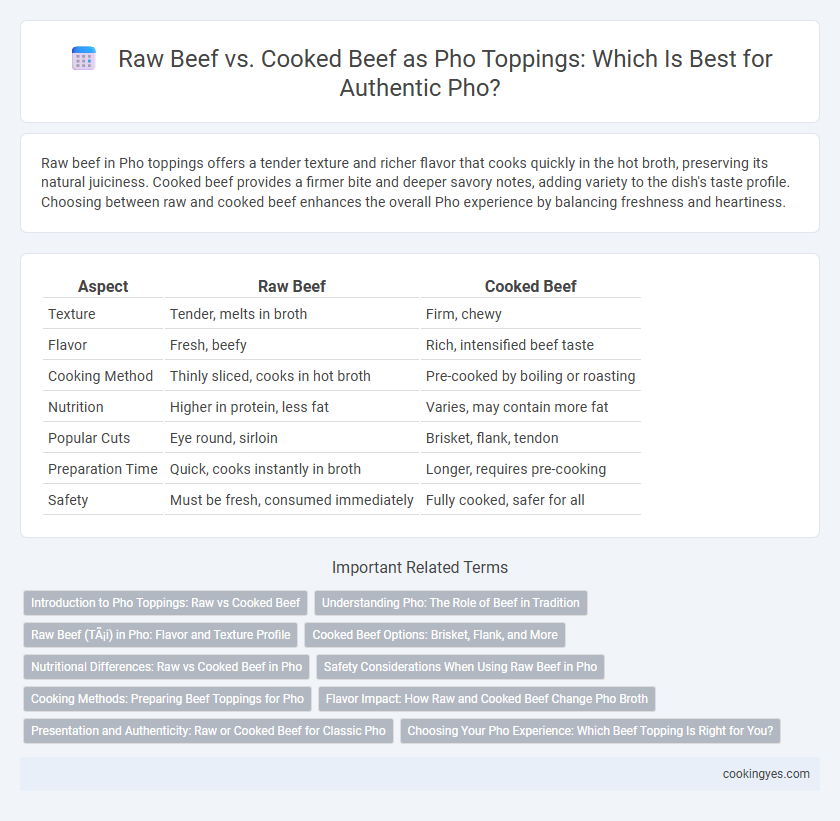Raw beef in Pho toppings offers a tender texture and richer flavor that cooks quickly in the hot broth, preserving its natural juiciness. Cooked beef provides a firmer bite and deeper savory notes, adding variety to the dish's taste profile. Choosing between raw and cooked beef enhances the overall Pho experience by balancing freshness and heartiness.
Table of Comparison
| Aspect | Raw Beef | Cooked Beef |
|---|---|---|
| Texture | Tender, melts in broth | Firm, chewy |
| Flavor | Fresh, beefy | Rich, intensified beef taste |
| Cooking Method | Thinly sliced, cooks in hot broth | Pre-cooked by boiling or roasting |
| Nutrition | Higher in protein, less fat | Varies, may contain more fat |
| Popular Cuts | Eye round, sirloin | Brisket, flank, tendon |
| Preparation Time | Quick, cooks instantly in broth | Longer, requires pre-cooking |
| Safety | Must be fresh, consumed immediately | Fully cooked, safer for all |
Introduction to Pho Toppings: Raw vs Cooked Beef
Pho toppings vary greatly between raw and cooked beef, each offering distinct textures and flavors that define the dish's authenticity. Raw beef, typically thinly sliced sirloin or eye of round, gently cooks in the hot broth, delivering a tender, silky bite that highlights the freshness of the meat. Cooked beef options, such as brisket or beef tendon, provide a richer, more robust flavor and a chewier texture, enhancing the complexity of the pho experience.
Understanding Pho: The Role of Beef in Tradition
Pho traditionally features thinly sliced raw beef that cooks instantly when immersed in the hot, aromatic broth, preserving its tender texture and fresh flavor crucial to the dish's authentic taste. Cooked beef varieties, such as brisket or flank, offer a richer, deeper flavor profile and a heartier bite, complementing the delicate balance of herbs and spices. Embracing both raw and cooked beef options enhances the sensory experience while honoring the culinary heritage and regional variations of Pho.
Raw Beef (Tái) in Pho: Flavor and Texture Profile
Raw beef (Tai) in Pho offers a tender, melt-in-the-mouth texture that contrasts beautifully with the rich, aromatic broth, enhancing the overall sensory experience. Its delicate flavor remains lightly beefy and fresh, allowing the savory notes of the broth and herbs to shine without overpowering them. Thinly sliced, the raw beef cooks slightly in the steaming hot soup, delivering a perfect balance of softness and subtle chewiness that defines authentic Vietnamese Pho.
Cooked Beef Options: Brisket, Flank, and More
Cooked beef options for Pho toppings include brisket, flank, and tendon, each bringing unique textures and flavors to the dish. Brisket offers a tender, slightly fatty bite, while flank provides a leaner, more fibrous texture that soaks up the savory broth effectively. Beyond these, eye-round and beef shank are favored for their rich, gelatinous qualities that enhance the Pho experience.
Nutritional Differences: Raw vs Cooked Beef in Pho
Raw beef used in pho toppings retains higher levels of certain heat-sensitive vitamins, such as vitamin B12 and folate, which can diminish during cooking. Cooked beef offers increased protein digestibility and safer consumption by eliminating harmful bacteria, but it may lose some moisture and nutrients through the cooking process. Balancing raw and cooked beef in pho allows for a combination of enhanced nutrient retention and food safety.
Safety Considerations When Using Raw Beef in Pho
Raw beef in pho requires strict adherence to food safety standards to minimize the risk of foodborne illnesses such as E. coli and Salmonella. The beef must be sliced thinly and served immediately, relying on the hot broth to cook it through to a safe internal temperature. Using high-quality, fresh beef from reputable sources further reduces contamination risks and ensures a safer dining experience.
Cooking Methods: Preparing Beef Toppings for Pho
Raw beef slices, typically thinly shaved, are added directly to the hot Pho broth, allowing gentle cooking through residual heat that preserves tenderness and delicate flavor. Cooked beef toppings such as brisket, flank, or tendon undergo slow simmering or braising to achieve a rich, tender texture, enhancing the broth's depth. Combining both raw and cooked beef toppings provides a dynamic contrast in texture and flavor, central to authentic Pho preparation.
Flavor Impact: How Raw and Cooked Beef Change Pho Broth
Raw beef slices gently cook in the hot pho broth, releasing a subtle, fresh beef flavor that enhances the soup's depth without overpowering it. Cooked beef toppings, like brisket or flank, contribute a richer, more concentrated meatiness, intensifying the broth's savory profile. The choice between raw and cooked beef significantly influences the overall umami balance, with raw beef preserving delicate notes and cooked beef adding hearty robustness.
Presentation and Authenticity: Raw or Cooked Beef for Classic Pho
Raw beef in classic pho offers a visually striking presentation with thin, translucent slices that cook gently in the hot broth, preserving authentic Vietnamese flavors and textures. Cooked beef, often brisket or flank, provides a hearty, richer taste and a firmer texture that reflects traditional preparation methods used in many pho regions. Choosing raw beef emphasizes authenticity through its interactive dining experience and fresher appearance, while cooked beef maintains a consistent, deep flavor profile preferred by many pho enthusiasts.
Choosing Your Pho Experience: Which Beef Topping Is Right for You?
Raw beef slices, often added to Pho just before serving, cook quickly in the hot broth, delivering tender texture and rich, natural flavor. Cooked beef toppings, such as brisket or flank, offer a deeper, concentrated taste with a firmer bite, enhancing the broth's savory profile. Choosing between raw or cooked beef depends on your preference for delicate freshness or robust, well-developed beef flavors in your Pho experience.
Raw beef vs cooked beef for Pho toppings Infographic

 cookingyes.com
cookingyes.com